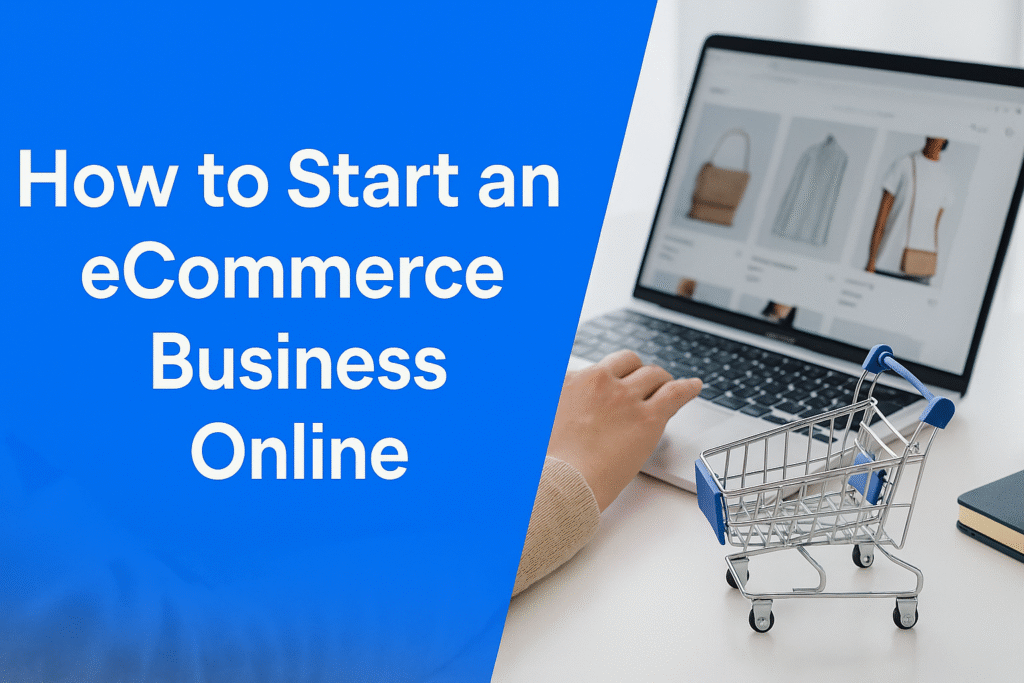
Starting your own eCommerce business can be exciting—and highly profitable if done right. With global online shopping trends booming and India’s digital economy rapidly growing, there’s no better time to launch your online store.
Whether you’re selling hand-painted sarees, customized mugs, or fitness gear, this comprehensive guide will walk you through every step, from idea to income.
✅ Step 1: Choose Your Niche
Before jumping in, pick a specific niche where you can stand out.
🔍 Why Niche Matters:
- Easier to market
- Builds brand loyalty
- Less competition than general stores
🧠 Ask Yourself:
- What products are in demand?
- What are you passionate about?
- What problems can you solve?
Examples:
- Eco-friendly kitchen products
- Premium pet accessories
- Hand-embroidered ethnic wear
- Digital planners for productivity
✅ Step 2: Decide What You’ll Sell
You can sell:
- Physical products: clothes, beauty, tech accessories
- Digital products: courses, eBooks, templates
- Services: consulting, coaching, event planning
Common Models:
| Model | Description |
|---|---|
| Own products | Handmade, manufactured, curated |
| Dropshipping | No inventory—ship from supplier |
| Print-on-demand | Customized goods printed & shipped on demand |
| Reselling | Wholesale to retail via your store |
✅ Step 3: Validate Your Product Idea
Ways to Validate:
- Look at Amazon bestsellers
- Use Google Trends to check seasonality
- Survey friends, communities, or Reddit forums
- Research competitors (pricing, USPs, reviews)
Tools to Use:
👉 Ubersuggest, SEMrush, SimilarWeb, Etsy, Pinterest, YouTube
✅ Step 4: Register Your Business
To build trust and run legally, you need basic documentation.
In India, you’ll need:
- Business name & logo
- GST registration
- Udyam/MSME registration (optional but helpful)
- PAN & bank account
- Trademark (optional)
You can run as a:
- Sole Proprietor
- Partnership or LLP
- Private Limited Company (for scaling)
✅ Step 5: Build Your Online Store
You need a professional website with:
- Easy navigation
- Mobile responsiveness
- Clear product pages
- Fast checkout process
eCommerce Platforms:
| Platform | Pros |
|---|---|
| Shopify | Easy to set up, great templates |
| WooCommerce | Full control, works with WordPress |
| Wix | Drag and drop, beginner-friendly |
| Magento | Powerful, for big stores |
Must-Have Website Pages:
- Home
- Product listings
- About Us
- Shipping & Returns
- Contact
- FAQ
- Blog (optional)
✅ Step 6: Set Up Payments & Shipping
Payment Gateways:
- Razorpay
- PayU
- Stripe
- Cashfree
- PayPal (for international orders)
Shipping Partners:
- Shiprocket
- Delhivery
- BlueDart
- India Post
- Amazon FBA (for marketplaces)
Add COD (Cash on Delivery) for better conversions in India.
✅ Step 7: Prepare Product Listings
Key Elements:
- High-quality photos (use mockups or photoshoots)
- Compelling product descriptions
- Clear benefits and use cases
- Reviews/social proof (if possible)
Tip: Use lifestyle images, not just plain ones.
✅ Step 8: Launch Your Store
Before going live:
- Test orders & payment
- Set up email confirmations
- Optimize mobile experience
Launch Promotions:
- Influencer collaborations
- Free shipping / limited time discounts
- Launch giveaway or contest
- Collect emails for future marketing
✅ Step 9: Market Your eCommerce Store
You can’t just build it and wait—you have to market aggressively.
Paid Marketing:
- Meta Ads (Instagram/Facebook)
- Google Shopping Ads
- WhatsApp Marketing
Organic Marketing:
- SEO (search-friendly content and products)
- Instagram Reels & Pinterest Pins
- Email campaigns
- YouTube product demos
Tools:
- Meta Ads Manager
- Canva for creatives
- Mailchimp or Klaviyo
- Google Analytics & Search Console
✅ Step 10: Track, Analyze & Scale
Metrics to Track:
- Conversion rate
- Add-to-cart rate
- Traffic sources
- CAC (Customer Acquisition Cost)
- AOV (Average Order Value)
- ROAS (Return on Ad Spend)
How to Scale:
- Retargeting ads
- Influencer UGC campaigns
- Loyalty programs
- Cross-selling & upselling
🧰 Bonus Tools for eCommerce Founders
| Purpose | Tool |
|---|---|
| Design | Canva, Figma |
| Analytics | Google Analytics, Hotjar |
| Email Marketing | Mailchimp, Klaviyo |
| Ad Management | Meta Ads Manager |
| Logistics | Shiprocket, Pickrr |
| Store SEO | Yoast (WordPress), Smart SEO (Shopify) |
| Product Sourcing | IndiaMart, Alibaba, Meesho |
📌 Final Thoughts
Starting an eCommerce business is a journey, not a shortcut. Stay consistent, test often, and listen to your audience. The beauty of eCommerce is scalability—once you get it right, it can grow rapidly with smart marketing and good customer service.
Source : Chatgpt
Keywords : #howtostartanecommercebusiness #ecommercebusinesssetup #startinganecommerce businessstep-by-step #howtocreateanonlinestore